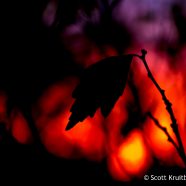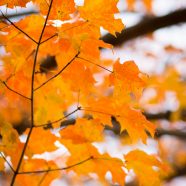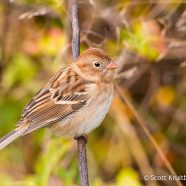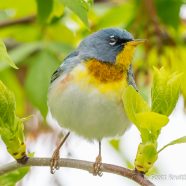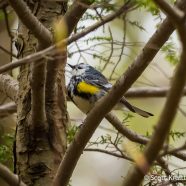Fall Sunset
This was a surprising sunset last week on a day that I did not expect any sort of light show. It turns out that the clouds parted just enough to let the light in while getting that special glow. Unfortunately I was rather far from any water or hill, unable to get a great view of a spectacular scene unfolding so rapidly and ending so briefly. After a moment of thought – and a minute of two of running for my camera and swapping lenses – I noticed that I was soaking in the sunset from behind the bare branches and falling leaves. I decided to take advantage of that and shoot some...
Read MoreOrange Blaze
Honestly, if the fall foliage could go on nonstop without end, it seems most of us would like it…
Read MoreField Sparrow
The Field Sparrow (Spizella pusilla) is an underrated little bird! Look at that bold eye ring and those beautiful brown tones with a pretty pink bill. Whenever I see those Fields in numbers in October it always suggests we are nearing the end of autumn avian migration. If we are lucky we may be able to spot one or two overwintering in the region, perhaps on a Christmas Bird Count, but most will be seeking less snowy quarters so they can enjoy easy to reach seeds all winter long. Nevertheless, if there aren’t any fields, grasslands, farms or other open areas – or if these habitats...
Read MoreNorthern Parula
Here we have the Northern Parula (Setophaga americana) as photographed while feeding this past Sunday morning after a busy night of migration. These little birds sound like zippers with a hard ending, or sometimes the “That’s all Folks!” song from Looney Tunes after several fast da and be notes. Those white eye crescents stand out from afar on a blue gray bird with a white belly featuring that bright yellow throat and upper chest with a reddish brown band. Northern Parulas are a gleaning species, snatching insects and spiders from tree branches and especially caterpillars...
Read MoreLeucistic Yellow-rumped Warbler
Here is that unique Yellow-rumped Warbler which I mentioned in a previous post. Can you see what looks different about it? I noticed it naked eye while tracking various subjects in a loose flock through the trees last week including more Yellow-rumps, Black-and-white Warblers, Blue-headed Vireos, and Blue-gray Gnatcatchers. After I got my binoculars on it I realized this bird was partially leucistic, and I quickly raised my camera to snap off a record photo. Leucism in birds is when melanin pigments are produced at less than normal levels or in an unexpected pattern. In this case many of the...
Read More



